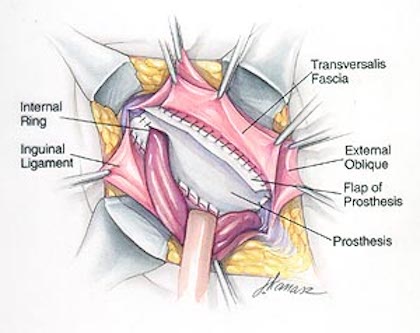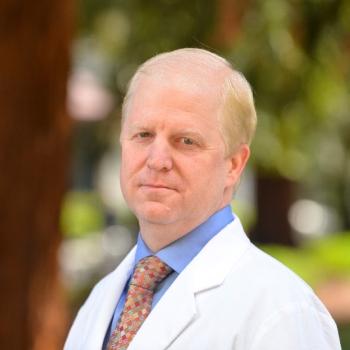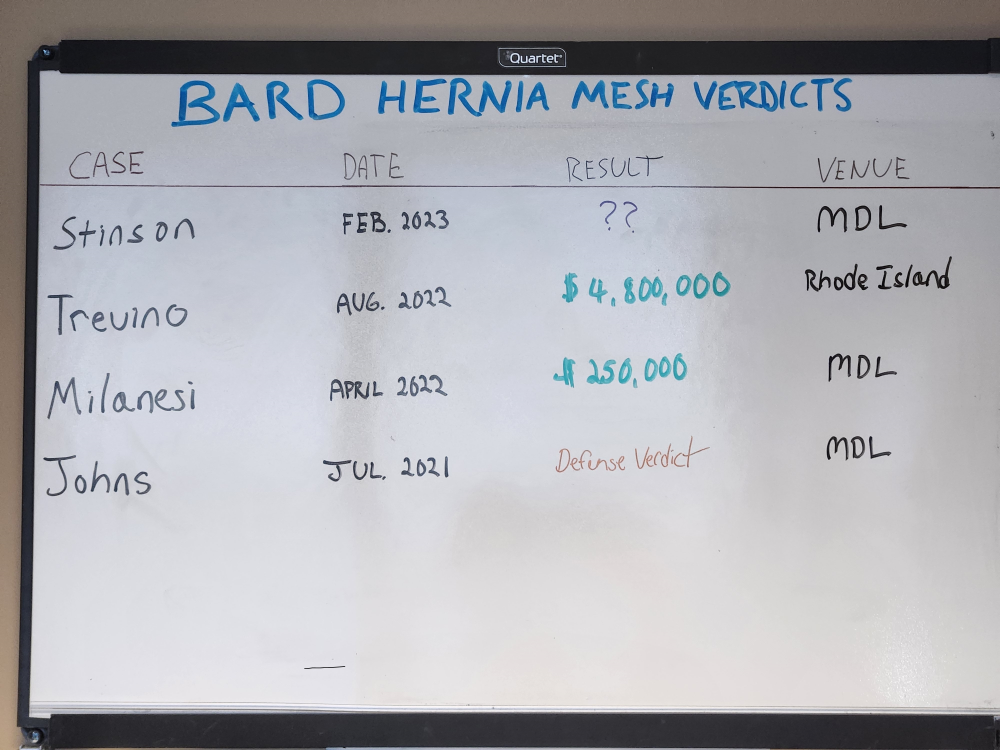
Good intentions
Forum Replies Created
-
That seems unlikely, combining mesh of any kind with a Shouldice-type repair. The only report I’ve seen of anybody doing something like that is from Dr. Grishkan’s practice. And he used a Gore mesh, PTFE based, not a biologic.
Can you supply the surgeon’s name?
Here is something about Dr. Grishkan’s method. The site has some bad information, like describing nylon mesh as a type of polypropylene.
https://herniasurgeries.com/hernia-surgery-technique-with-mesh/
herniasurgeries.com
The Modified Shouldice Hernia Surgery Technique - WITH MESH (Panel 5) - Hernia Center of Ohio
Panel No. 5 There are rare cases where surgical findings demonstrate insufficient or very weak tissue to perform a Shouldice repair. These can be due to multiple prior failed hernia repairs, the prior use of mesh and a history of … Continue reading
-
Most of the development work was done for ventral repairs. The product was introduced for the inguinal hernia repair market based on a 31 patient study by a single surgeon. There was a two year followup study done of 157 patients, but it was not a typical inguinal hernia mesh implantation method. The surgeon sutured the defect closed first then placed the mesh. So, it’s not really applicable to what a typical patient would get. It does look good for marketing purposes though. Good luck finding a good one-to-one comparison with synthetic mesh.
https://finance.yahoo.com/news/tela-bio-highlights-results-bravo-110000480.html
“Robotic Reinforced Biologic Augmented Repair (ReBAR) of Over 150 Inguinal Hernias: 2-Year Outcomes
AHS presentation on Wednesday, September 14th, 11:20-11:30 a.m.ET
This retrospective study examined the two-year recurrence rate of the robotic-assisted reinforced biologic augmented repair (ReBAR) of inguinal hernias from June 2018 to April 2022. All repairs employed the standard robotic transabdominal preperitoneal (rTAPP) approach combined with the novel ReBAR technique, which consists of suture closure of the defect followed by a biologic mesh reinforcement. After two years, only three recurrences were identified from the 157 inguinal hernias repaired using the ReBAR technique – a rate of 1.9%, and only two SSOs were identified in this cohort.”
finance.yahoo.com
24-Month BRAVO study results showed a 2.6% recurrence rate in diverse clinical scenarios Robotic Reinforced Biologic Augmented Repair (ReBAR) study showed a 1.9% recurrence rate at two-year mark MALVERN, Pa., Aug. 04, 2022 (GLOBE NEWSWIRE) -- TELA Bio, Inc. (NASDAQ: … Continue reading
-
It is still a very new product. But, really, it is not much different than any of the other biologic meshes.
The stock price has dropped dramatically since it went public at $13 per share even though the general stock market has increased dramatically. It’s just one of several of their products but there’s not much sign that it’s meeting its promises.
https://finance.yahoo.com/quote/TELA/
finance.yahoo.com
TELA Bio, Inc. (TELA) Stock Price, News, Quote & History - Yahoo Finance
Find the latest TELA Bio, Inc. (TELA) stock quote, history, news and other vital information to help you with your stock trading and investing.
-
Is your surgeon claiming not to know of anyone that performs mesh removal? If they are willing to do an injection they must be aware of mesh removal. It’s mainstream surgery now.
-
Hernias are typically “located” by the material that pushes through the weakness in the abdominal wall. During mesh implantation that material is either dissected or pushed back to where it came from. After mesh implantation the whole area shrinks, removing any signs of the previous hernia.
But, direct hernias are defined as weaknesses in the posterior wall of the inguinal canal. So if that’s what you had then that’s where a surgeon would look. The posterior wall will still be the posterior wall.
An exploratory lap procedure would have been a TAPP procedure. Often the mesh can be seen through the peritoneum, but if you had a TEP implantation the peritoneum was never breached so there will be no signs of where it was placed. During my mesh removal the peritoneum looked perfect, everything was smooth and normal.
When you say that you can feel the edges of the mesh with your finger do you mean that your finger feels it or that pressure with your finger allows you to feel it inside?
Anyway, overall, if you have mesh problems you’ll need to find a surgeon that has removed mesh and had success. They are the only ones that have real world experience in mesh problems and solutions, and will be confident enough to break through the perfect looking peritoneum to remove the mesh or find out out what is wrong with it. Because from inside the peritoneum there will be no signs of problems.
-
I would contact the Shouldice Hospital. They might be able to recommend somebody.
-
The Gibbeum Hospital with Dr. Kang seems to meet your desires. Mainstream hernia repiar today is mesh implantation under general anesthesia. Many different types of mesh possible but the basics are the same for the majority of patients.
-
Did the bulge get bigger? Does it change in shape and size? Or do you just have new soreness?
Are you limited to Pennsylvania or can you travel to other states, like New York? There are well-known surgeons in New York.
Did you copy the bulk of your description from somehwere else? This forum has problems with text copied and pasted in to the Reply box at times. All of the odd characters and font description words in your post are a sign that you pasted it in.
-
Good intentions
MemberApril 3, 2024 at 11:10 am in reply to: Bay Area hernia surgeon recommendationsThey’re all laparoscopy surgeons. They all seem well-educated, some are teachers. You’ll get the standard mesh implantation from any of them.
https://profiles.stanford.edu/james-korndorffer
profiles.stanford.edu
James R. Korndorffer, Jr. MD, MHPE, FACS's Profile | Stanford Profiles
James R. Korndorffer, Jr. MD, MHPE, FACS is part of Stanford Profiles, official site for faculty, postdocs, students and staff information (Expertise, Bio, Research, Publications, and more). The site facilitates research and collaboration in academic endeavors.
-
Good intentions
MemberApril 3, 2024 at 11:10 am in reply to: Bay Area hernia surgeon recommendationshttps://provider.elcaminohealth.org/marc-zare-md-1639286214-1
provider.elcaminohealth.org
Marc Zare, MD | General Surgery | Los Gatos
Dr. Marc Zare is a board-certified surgeon who specializes in advanced laparoscopic surgery. He’s passionate about providing safe, minimally invasive surger
-
Good intentions
MemberApril 3, 2024 at 11:10 am in reply to: Bay Area hernia surgeon recommendations-
Good intentions
MemberApril 3, 2024 at 11:11 am in reply to: Bay Area hernia surgeon recommendationsgastricbypasssanfrancisco.com
John J. Feng, MD specializes in advanced laparoscopic and minimally invasive weight loss, or bariatric surgery. He has dedicated his practice to several methods of bariatric surgery, all of which can be performed laparoscopically. He believes that surgery can be … Continue reading
-
-
-
-
Here is a link to your post from 5 weeks ago. Did you try the suggestions?https://herniatalk.com/forums/topic/mesh-removal-3/
herniatalk.com
Mesh Removal - Hernia Discussion - Hernia Talk
Mesh Removal - Hernia Discussion - Hernia Talk
-
Hello William. I am no expert on legal issues. But as I read this, the judge has decided that there is enough information available from the previous trials for the two parties to come to a settlement agreement. I think that the judge is making the plaintiffs’ representation decide if they really want to try each case individually, and the defendants decide if they want to take the risk of paying out a large number of individual settlements for each future lost case.
I think that the situation is unusual in that the products are still for sale. So if the device makers decide to take the chance on paying individual cases they are looking at a continuous stream of settlement payments, even past those of the plaintiffs in the class action. Each individual case will set precedent for future cases. On the other hand, the plaintiffs’ lawyers will have a huge amount of work in front of them, recruiting and training lawyers for the individual cases. I’m just guessing, I don’t really know how it would work. But that seems like the game of chicken that is being played.
One interesting aspect of remanding back to the individual’s districts is that each individual case will bring in more and more varied discovery. The surgeons will be involved along with others involved in each procedure. It could get really messy. In one of the cases the device maker’s lawyers tried to blame the surgeon fo “failure to inform”. Many of the plaintiffs probably would not have sued if there wasn’t a class action to join. But now that it is happening it seems more likely that many will continue. They have already retained counsel and started the process. Thousands of people testifying under oath about the failed promises and after the surgery gaslighting, avoidance, and deflection when they had problems.
I think that most class action lawsuits are filed for products that have been removed from market. Like 3M’s defective ear plug suit. The lawsuits are attempts to make the damaged parties whole for past transgressions. But here, the settlement payments will have to be figured in to the future costs of the products, since the same products are still being sold and will have the same ratio of problems. Or the pre-surgery disclosures will be so explicit that people will avoid the products. So far, there seems to be no progress at all on disclosure either. Same products, same disclosures, same stories. No change. Because, I assume, it would show that they knew and did nothing.
I wonder if anyone has considered suing the FDA for their approval of these damaging products and the lack of oversight in recognizing the issues reported in their own database. I could see a jury voting to make the government responsible. They’re not doing their job.
It’s easy to imagine that the class action gets settled but the individual cases continue. What is “supposed to happen” is that the bad products are removed from market after a large class action suit. But I think that the mesh repair money is just too good and that there are probably ways to pass the payment costs on to the public as a whole, through the insurance companies. At the end of the day it’s always about the money.
Pretty fascinating. Thanks for bringing it up again. Maybe somebody with actual law education/experience can explain more.
-
Two months of “mediation” talks ahead and probably nothing decided at the end. Meanwhile, no changes by the device makers. I am seeing more mentions of Phasix though. The absorbale mesh.
“<b style=”background-color: var(–bb-content-background-color); font-family: inherit; font-size: inherit; color: var(–bb-body-text-color);”>March 25, 2024 Update
The first day of the mediation was today. There is no news. There may be news tomorrow. The most realistic good news would be another scheduled mediation and a report of progress.
March 5, 2024 Update
Judge Sargus has issued an order outlining a mediation plan and schedule aimed at facilitating a settlement in the Bard hernia mesh MDL. The order schedules an in-person mediation session for March 25 and March 26, 2024 (it was originally scheduled earlier in the month). The mediator is John Jackson
If there is no settlement by May 24, 2024, the parties need so submit a plan to advance the litigation. I doubt that will be a joint plan if it comes to it. Let’s just hope these cases can get settled.”
https://www.lawsuit-information-center.com/bard-hernia-mesh-lawsuits.html
lawsuit-information-center.com
Hernia Mesh Lawsuit Against C.R. Bard
C.R. Bard is defending over 18,000 hernia mesh lawsuits alleging that its mesh devices were defective, resulting in injuries and complications for thousands of hernia surgery patients. Our hernia ...
-
-
I’m not sure what you mean by “will do”. If you just talked to the surgeon do you not know their name?
Here’s a video about Ovitex biologic. It does not appear to be absorbed or decomposed or replaced by body collagen at all. It looks like it probably did when it was implanted, 1.5 years earlier. It peeled out pretty easily. You can clearly see the polypropylene reinforcement fibers on the surface.
-
“Bumping” this to the top. I have no idea where this post will end up in the thread but the thread should become more visible in general.
-
You should be able to find somebody who does the Desarda repair. Researchers in India have published about it.
https://www.sciencedirect.com/science/article/pii/S2049080121004362
-
Good intentions
MemberApril 3, 2024 at 2:45 pm in reply to: Bay Area hernia surgeon recommendationsRead through old posts on the forum. You’ve probably seen them already.
-
Who have you contacted so far? Many people have had mesh removed in other parts of the country. The experiences are all about the same. The mesh is removed, pain is diminshed, healing and recovery takes a long time.
A plug would most likley be removed via an open procedure. Dr. Towfigh has posted on Twitter about plugs.
https://twitter.com/Herniadoc/status/1021561699290116097
What do you see?
— Dr. Shirin Towfigh (@Herniadoc) July 24, 2018
This is a medium size Perfix #plug #mesh that has balled up, aka #meshoma . It was causing chronic groin & nerve #pain due to erosion into the spermatic cord, so I excised it. He is now #pain free!🙏🏻#meshcomplication #hernia #chronicpain #itsnotjustahernia pic.twitter.com/EgnLh0ULXR







